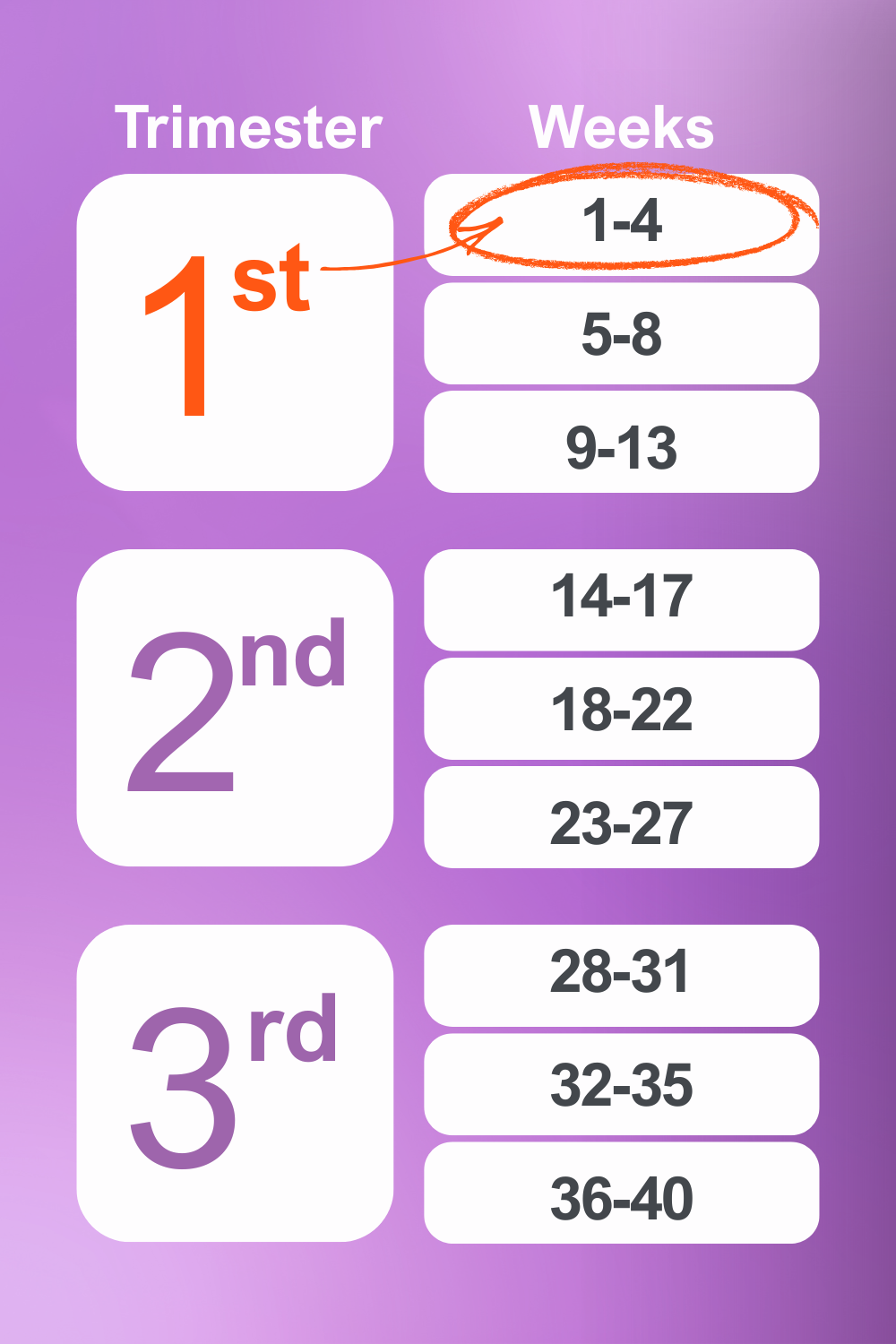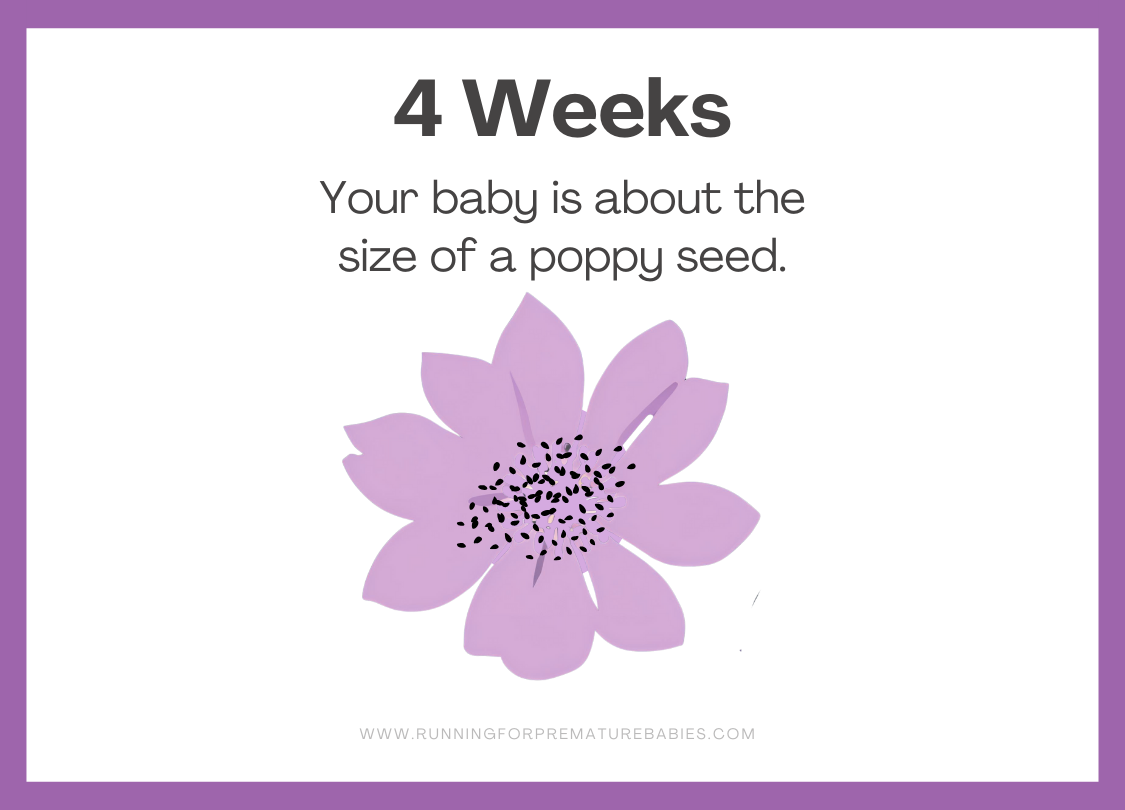Key Milestone Weeks in Pregnancy
First Trimester

3-4 Weeks Pregnant: Fertilisation and implantation; organ development begins.
Summary:
At 3-4 weeks pregnant, the most common early signs include a missed period, breast tenderness, nausea (often called morning sickness), fatigue, mood swings, and frequent urination. These symptoms result from rising pregnancy hormones like hCG and progesterone. Inside your body, fertilisation has occurred, and the fertilised egg (now a blastocyst) travels to the uterus and implants into the uterine lining - marking the true start of pregnancy. A home pregnancy test can usually detect this by the end of week 4. Your baby is just 0.2 mm wide, about the size of a poppy seed, and while no organs have formed yet, foundational cells for all major systems are beginning to develop. Mild cramping or light spotting at this stage can be normal, often related to implantation.
- Morning sickness, nausea and/or vomiting that may come and go throughout the day
- Breast changes including tenderness, increase in size or a tingling sensation
- Feeling tired
- Dizziness
- Mood swings
- Food cravings or aversions to food
- Needing to pass urine more often
- Abdominal pain or bloating

At 3-4 weeks pregnant, what is happening inside my body?
At 3-4 weeks pregnant, fertilisation occurs where the sperm and egg meet to form a a single cell called zygote. Over the next 4–5 days, the zygote travels down the fallopian tube, dividing into a blastocyst. By the end of week 4, the blastocyst now containing 50-200 cells implants into the uterine lining, officially beginning pregnancy. Hormones such as progesterone and hCG are rising rapidly, supporting the uterine lining and preventing menstruation. These hormonal shifts also trigger many early pregnancy symptoms.
At 3–4 weeks pregnant, what is happening with my baby?
At 3-4 weeks pregnant, your baby is still in the earliest stages of development and is incredibly tiny, about the size of a poppy seed or a pinhead. It is about 0.2mm wide and contains approximately 200 cells that are continuing to multiply. Though small, the blastocyst is beginning to form the amniotic sac and yolk sac, which are essential for your baby’s nourishment and protection in the early weeks. Cellular layers are starting to develop into the brain, spinal cord, heart, and gastrointestinal tract.
See FAQs Below
Get Involved
Run with us
Donate
Join the Premmie Marathon Challenge
FAQs
Can you get a positive pregnancy test at 3–4 weeks?
Yes. By week 4, your body produces enough hCG (human chorionic gonadotropin) for a home pregnancy test to detect. Testing with first morning urine improves accuracy. If your result is negative but your period hasn’t started, test again in a few days.
When should I see a doctor?
When do pregnancy symptoms start?
Medically, symptoms can start as early as implantation (6–10 days after ovulation), but many women notice changes around the time of a missed period. This is typically 3–4 weeks into pregnancy. However, some women may not experience noticeable symptoms at all this early.
What should I eat or avoid in my diet?
At 3-4 weeks pregnant your diet plays a vital role in supporting both your health and your baby’s development.
What to Eat:
- Plenty of vegetables and fruit – Aim for a variety of colours and types.
- Wholegrains – Choose high-fibre options like wholegrain bread, brown rice, and oats.
- Lean proteins – Such as cooked meat, poultry, fish, eggs, tofu, legumes, and nuts.
- Dairy or alternatives – Opt for pasteurised and reduced-fat milk, cheese, and yoghurt.
- Healthy fats – Small amounts of unsaturated fats like olive oil or avocado.
- Folic acid, iodine, and iron-rich foods – These nutrients are especially important during pregnancy.
What to Avoid:
- Raw or undercooked meat, poultry, and seafood – Due to risk of listeria, toxoplasmosis, and salmonella.
- Deli meats and soft cheeses (e.g. brie, camembert, feta) – Unless thoroughly cooked.
- Raw eggs or foods containing them – Like homemade mayonnaise or mousse.
- Soft-serve ice cream and unpasteurised dairy – Due to listeria risk.
- Large fish (e.g. shark, marlin, swordfish) – High in mercury, which can affect baby’s brain development.
- Alcohol – Best avoided entirely.
- Limit caffeine – No more than 1–2 cups of coffee or 4 cups of tea per day.
Can I exercise at 3-4 weeks pregnant?
You can generally exercise at 3–4 weeks pregnant, and in fact, staying active is encouraged, as long as you feel well and your pregnancy is progressing normally.
Safe exercise tips:
- Stick to moderate-intensity activities like walking, swimming, or prenatal yoga.
- Listen to your body. If you feel tired, dizzy, or unwell, take a break.
- Stay hydrated and avoid overheating.
- If you were active before pregnancy, you can usually continue your routine with slight modifications.
- If you’re new to exercise, start gently and build up gradually.
Avoid:
- High-impact or contact sports.
- Exercises that risk falling or abdominal trauma.
- Overexertion. Use the “talk test” where you should be able to hold a conversation while exercising.
Is cramping or spotting normal?
Mild cramping and light spotting can be normal in early pregnancy, especially around 3 to 4 weeks pregnant. These symptoms are often linked to implantation when the fertilised egg attaches to the uterine lining. This can cause light bleeding (implantation bleeding) and a sensation similar to period cramps.
When should I tell people I am pregnant?
Many people choose to wait until 12 weeks when the risk of miscarriage drops significantly. Others prefer to share the news early, especially with close family or friends who can offer support no matter what happens. This is a personal choice with no right or wrong answer. Ultimately, it’s about what is right for you.
Early Pregnancy Care Principles
The latest guidelines and care principles for early pregnancy include:
- Early antenatal visits: Are encouraged to confirm the pregnancy, estimate gestational age, and begin discussions about lifestyle, nutrition, and mental health.
- Folic acid supplementation: Strongly recommended to reduce the risk of neural tube defects, which are forming around week 5 of pregnancy.
- Screening for risk factors: This includes assessing for miscarriage risk, preeclampsia, and mental health concerns like anxiety or depression.
- Lifestyle guidance: Advice on avoiding alcohol, tobacco, and certain medications is emphasised early on, along with support for healthy eating and physical activity.
- Cultural and individualised care: The guidelines stress the importance of woman-centred care, especially for Aboriginal and Torres Strait Islander women, migrants, and those with complex needs.
Related reading:
First Trimester
What to expect when you're 3-4 weeks pregnant
What to expect when you're 5 weeks pregnant
What to expect when you're 6-9 weeks pregnant
What to expect when you're 10 weeks pregnant
What to expect when you're 12 weeks pregnant
What to exprect when you're 14 weeks pregnant
Second Trimester
What to expect when you're 18 weeks pregnant
What to expect when you're 20 weeks pregnant
What to expect when you're 22-23 weeks pregnant
What to expect when you're 24 weeks pregnant
What to expect when you're 26-27 weeks pregnant
Third Trimester
What to expect when you're 28 weeks pregnant
What to expect when you're 29 weeks pregnant
What to expect when you're 30 weeks pregnant
What to expect when you're 32-33 weeks pregnant
What to expect when you're 34 weeks pregnant
What to expect when you're 36 weeks pregnant
What to expect when you're 37 weeks pregnant
What to expect when you're 38-40 weeks pregnant
If you would like to run with us, either in memory of a precious baby, to celebrate new life, or simply to add purpose to your fitness journey, click here to find out how you can help give babies a better chance of survival.
Pregnancy, Birth and Baby. (n.d.). Early signs of pregnancy. Australian Government. Retrieved 17th June 2025 https://www.pregnancybirthbaby.org.au/early-signs-of-pregnancy
Australian Government Department of Health and Aged Care. (2023, November). Physical activity and exercise during pregnancy: Guidelines brochure. Retrieved 17th June 2025 https://www.health.gov.au/sites/default/files/2023-11/physical-activity-and-exercise-during-pregnancy-guidelines-brochure.pdf


